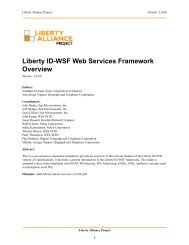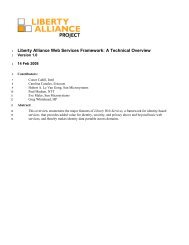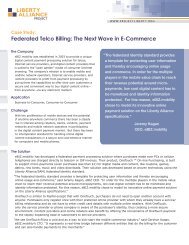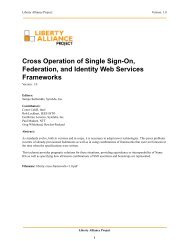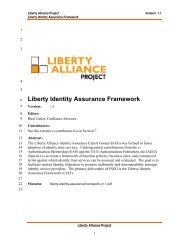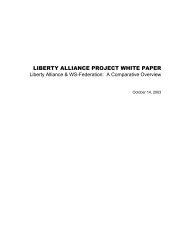Liberty ID-FF Bindings and Profiles Specification - Liberty Alliance
Liberty ID-FF Bindings and Profiles Specification - Liberty Alliance
Liberty ID-FF Bindings and Profiles Specification - Liberty Alliance
Create successful ePaper yourself
Turn your PDF publications into a flip-book with our unique Google optimized e-Paper software.
<strong>Liberty</strong> <strong>Alliance</strong> Project:<strong>Liberty</strong> <strong>ID</strong>-<strong>FF</strong> <strong>Bindings</strong> <strong>and</strong> <strong>Profiles</strong> <strong>Specification</strong>Version: 1.2-errata-v2.0104310441045104610471048104910501051105210531054105510561057105810591060106110621063106410651066106710681069107010711072107310741075107610771078107910801081108210831084• A component containing the protocol message as defined in [<strong>Liberty</strong>ProtSchema]with formatting as specified in Section 3.1.2Note:The element of the message can be used by the serviceprovider to help maintain state information during the single sign-on <strong>and</strong> federation process. Forexample, the originally requested resource (that is, RelayState in step 1) could be stored as the valuefor the element, which would then be returned to the service provider in the in step 7. The service provider could then use this information to formulate theHTTP response to the user agent in step 11.• An HTTP form containing the field LAREQ with the value of the protocol messageas defined in [<strong>Liberty</strong>ProtSchema]. The MUST be encoded by applying a base64transformation (see [RFC2045]).See the discussion of this step in the artifact profile for implementation examples.3.2.3.2. Step 6: Generating <strong>and</strong> Supplying the In step 6 the identity provider generates an HTML form containing an authentication assertion that MUST be sent inan HTTP 200 response to the user agent.The form MUST be constructed such that it requests a POST to the service provider’s assertion consumer URLwith form contents that contain the field LARES with the value being the protocolmessage as defined in [<strong>Liberty</strong>ProtSchema]. The MUST be encoded by applying a base64transformation (refer to [RFC2045]) to the <strong>and</strong> all of its elements. The service provider’sassertion consumer service URL used as the target of the form POST MUST specify https as the URL scheme; ifanother scheme is specified, it MUST be treated as an error by the identity provider.Multiple elements MAY be included in the response. The identity provider MUST digitally signeach of the assertions included in the response.The element of the assertion MUST be set to the value specified in [SAMLCore11]for "Assertion Bearer."3.2.3.3. Step 7: Posting the Form Containing the In step 7 the user agent issues the HTTP POST request containing the to the service provider.3.2.4. <strong>Liberty</strong>-Enabled Client <strong>and</strong> Proxy ProfileThe <strong>Liberty</strong>-enabled client <strong>and</strong> proxy profile specifies interactions between <strong>Liberty</strong>-enabled clients <strong>and</strong>/or proxies,service providers, <strong>and</strong> identity providers. See Figure 5. A <strong>Liberty</strong>-enabled client is a client that has, or knows how toobtain, knowledge about the identity provider that the Principal wishes to use with the service provider. In addition a<strong>Liberty</strong>-enabled client receives <strong>and</strong> sends <strong>Liberty</strong> messages in the body of HTTP requests <strong>and</strong> responses. Therefore,<strong>Liberty</strong>-enabled clients have no restrictions on the size of the <strong>Liberty</strong> protocol messages.A <strong>Liberty</strong>-enabled proxy is an HTTP proxy (typically a WAP gateway) that emulates a <strong>Liberty</strong>-enabled client. Unlessstated otherwise, all statements referring to "LECP" are to be understood as statements about both <strong>Liberty</strong>-enabledclients <strong>and</strong> <strong>Liberty</strong>-enabled proxies.In some environments the successful deployment of a <strong>Liberty</strong>-Enabled proxy may require that service providers inthose environments perform operations in addition to those described below. Such cases, <strong>and</strong> specific guidance forthem, are covered in [<strong>Liberty</strong>ImplGuide].The following URI-based identifier must be used when referencing this specific profile (for example, element of the message):<strong>Liberty</strong> <strong>Alliance</strong> Project29



